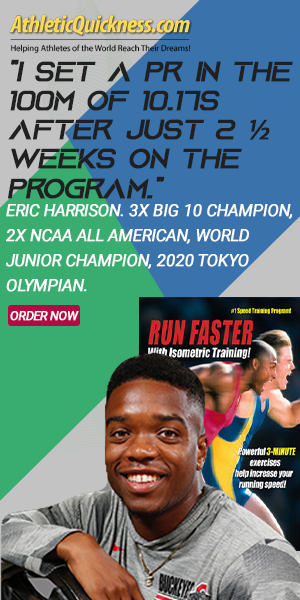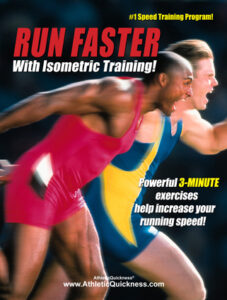Little Known Secrets of Speed Training
That Will Make You Faster in Days
The Swing Phase
Here I am going to continue to break down the running process and talk about the second phase of running, the swing phase and how conditioning your muscles for just this one phase will quickly make a huge improvement in your speed.
We are also going to discuss the dynamic role your hip flexor muscles play in this phase and also going to get into how and why your fast twitch muscle fibers respond very quickly and produce more speed when being trained with the resistance band using an isometric training strategy.
I am also going to show you an exercise that I know will make you a faster athlete beyond your wildest expectations. This exercise will help you compete at your highest levels and help you avoid the disappointments that other athletes typically experience when trying to get faster.
The Swing Phase and Hip Flexors
The second phase of the running process, called the swing phase, is where the trailing airborne leg needs to be pulled from behind you and quickly extended out in front of you. This is where your hip flexor muscles play a critical role in your sprinting speed, and there are 7 of these hip flexors on both sides of your body for a total of 14.
Your hip flexors are some of the longest and strongest muscles in your body, but they are essentially dormant in most athletes, meaning, they have never been activated for speed or exercised properly for any athletic function other than walking.
Some of them, like the psoas muscle, begin high up in your lumbar spine while others like the rectus femoris muscle starts out low on the pelvis; and, they all cross the hip joint. Most of them attach to your thigh while one of them, the Sartorius, is so long that it attaches just below the knee.
In a sense, your hip flexors bridge your upper body to your lower body. You might also think of them as acting like a hinge between your core and legs, allowing them to work together in unison.
As their name implies, their function is to flex the hip or to flex the thigh up on the pelvis and they play a major role in running, jumping and kicking.
Hip Flexors Go Unnoticed and Untrained
Because these muscles are hidden deep within the midsection of your body, they usually go unnoticed and untrained.
They are not considered a very glamorous muscle group to exercise, like your biceps, and this is why a lot of athletes aren’t even aware of them and completely ignore them in their workouts.
If you have weak hip flexors that are not properly developed, you will never perform at your highest level and will always feel like you are stuck in second gear.
There is probably not a worse feeling to have as an athlete than to feel slower than your opponent or not being able to make the play because you were just not fast enough. If this sounds like you, then we need to get to work on fixing this.
So, let’s take a look at your hip flexors in action during the swing phase in this video:
The Motion and Muscles of the Swing Phase
Training Hip Flexors will Quickly Improve Speed
The good news here is that training to improve your swing phase is not very difficult; however, it is perhaps one of the greatest oversights athletes make when attempting to train for speed.
The first thing I want to make sure get from this video is this: Properly training your hip flexors will quickly and significantly Improve your:
1) Running Speed
2) Jumping Height
3) Jumping Distance
4) Kicking Height
5) Kicking Distance
So, now my question for you is, What exercises are you doing right now to help you train for this swing phase motion?
Can you think of any? You might think about what exercises you have done to train your hip flexors, such as hanging leg lifts or perhaps certain sit-up type exercises done on a decline bench, maybe some work with a medicine ball, and if you came up with these or any others, are you really training the hip flexors to simulate the exact motion as they are used in the swing phase of running?
Chances are, you have never even bothered to train your hip flexors for this motion, is because there is no real good equipment in the gym to do so, and there was probably never any importance placed on them in the first place.
Now, some people have even gone so far as to dismiss this critical phase of running as not being important because they say, “There is no weight placed on the trailing leg during this motion, so why train for it?”
Well, this makes about as much sense as trying to tell a boxer not to practice throwing punches or to do any shadow boxing because there is no weight placed on their arms while punching, why train for it. Doesn’t make a lot of sense, does it?
An even bigger reason to train your hip flexors for the swing phase is what I said about this in the previous video: If all you do is train your leg muscles for the push phase of running, which is what most lower body training is all about, then you are not really training yourself to run, but instead, you are really only training yourself to jump.
I referred to the example of a frog where all they do is just push off and land, push off and land. And, if you recall, I pointed out when you observe another person running, you see more than just pushing. You see that each leg needs recycle itself in the running motion, again and again; and, that was called your turnover rate, and it affects your running speed a great deal.
If you have never trained for this swing phase motion before, don’t be upset. I am quite convinced that many people haven’t. The reason I say this is because I have been in contact with professional athletes on NBA championship teams and Superbowl winning teams and can personally tell you that professional athletes are still in the dark when it comes to training their hip flexors properly.
How to Train Hip Flexors For Speed
Most of them still don’t know what they are for! But, this is where you can make great strides, literally, in your athletic performance and take your game to the next level.
You might be thinking to yourself that the first thing you should do is go to the gym and perhaps tie a cable of some sort around your ankle and pull some weights simulating this swing phase motion, but that is probably not a good idea.
First, you might get hurt because to get the leverage needed to activate your hip flexors for speed, the force needs to be really heavy and dynamic, and if the weights get away from you, you can tear a muscle before you even get started.
Second, training with weights is great for adding size to your muscles and getting stronger, but it isn’t the best way to train your muscles to contract faster and for speed.
This is where the technique of using the resistance band with an isometric training strategy blows away any other speed training technique.
This has to do with how and where the force of the resistance band is distributed back into your muscles and tendons and this will be the subject of the fourth article in this series.
For now, let me state that the swing phase, which is controlled mainly by your hip flexor muscles, are absolutely loaded with fast twitch muscle fibers, the fibers that help your muscles contract with speed. While fast twitch fibers like to get big when you train them with weights, training with weights and getting bigger doesn’t always make them contract faster.
You may already know this to some extent simply by the way you feel after a heavy weight training workout. You may walk out of the gym with a good pump in your muscles, but you are probably at least twice as slow walking out of the gym than you were walking in to the gym.
Speed training programs, when done effectively, should leave you feeling lighter, faster and more responsive when you are finished and not tired, heavy and sluggish as with other training methods.
I realize this is a new concept for many of you, but it’s true,and you are going to get a chance to experience this for yourself here in a minute.
Now, we also know that the biggest and strongest guys in the gym or on the team aren’t always the fastest, right?
As an example, have you ever seen a big, powerful, professional football player or perhaps basketball player swing a golf club? I t’s not a pretty sight is it? Guys half their size and sometimes as much as 20 years older out out-swing them by as much as 30 mph
The second lesson and out-drive them easily by 50 yards or more.I want you to get from this video is this: Get it out of your head that you need to have big muscles to be fast. Sure it would be nice, but it’s not necessary.
Getting back to your hip flexors and their role in the swing phase of the running process, because they are loaded with fast twitch fibers: They respond incredibly well to being trained using the resistance band with an isometric training strategy; and whenever you train them this way, they always end up becoming quicker when finished, not slower.
This is also because on top of the muscles getting a more dynamic workout when forced to hold an isometric contraction using the band, so do the tendons that attach these fast twitch muscle fibers to the bone.
You see your tendons are also like huge elastic rubber bands and forcing them into an isometric contraction can make a huge difference in your speed and quickness.
This makes isometric training with resistance bands a perfect match when training for speed.
So, now, the third lesson I want to make sure you get from this video is this: Do not take the information presented in this exercise lightly.
This is where most of our athletes have started their journey to becoming 1) faster athletes; 2) stronger jumpers and 3) more powerful kickers and this includes a high school national sprint champion in the 60m dash.
If you apply yourself and follow the instructions, I know you will dramatically improve your athletic performance and start making the plays that wins games and get you noticed by coaches and scouts.
And, let me also just say, this is only one of the many dynamic speed training exercises that our athletes have done that are offered in our training programs. It’s also what many have credited with helping them get division one scholarships.
For now, your goal is to review the entire contents of this article and video, so you understand the importance of the swing phase and can take the necessary steps to improving your speed.
Doing so will put you on the fast track to better total performance in your sport. And, then, just imagine how much more confident and better athlete you will become if you were to do all the exercises in the RUN FASTER, JUMP HIGHER or KICK FARTHER with Isometric Training programs!
Always glad to help!
Dr. Larry Van Such






